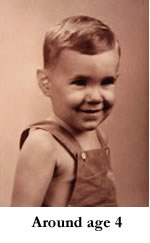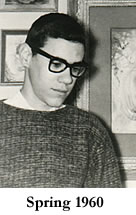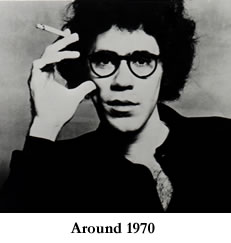 |
 |
 |
 |
 |
|
About Joe Brainard Joe Brainard was born in Salem, Arkansas, in 1942, but shortly thereafter his family moved to Tulsa, Oklahoma, where he grew up. From an early age Joe showed artistic talent, winning virtually every art contest he entered. He even designed his mother's dresses. |
|
|
Artistic talent seemed to run in the family. His paternal grandfather wrote poetry, his father drew and painted (until the obligation of supporting a family turned that into a fading dream), and two of Joe's three siblings became artists, aided by private art lessons. For Joe, art was a calling, but it was also a way that he, a gentle, skinny, unathletic stutterer, could deal with the world outside his home; the world of public school in a working-class neighborhood. |
 |
| At the age of 16 Joe got to know two fellow classmates who, like him, felt somewhat marginalized: poets Ron Padgett and Dick Gallup. Through them he met two graduate students at the University of Tulsa, the poet Ted Berrigan and Patricia Mitchell, both of whom would prove to be lifelong friends. Still in high school, Brainard, Padgett, and Gallup produced The White Dove Review, an art and literary magazine. | |
 |
After graduation and a few months of study at the Dayton Art Institute, which had given him a full scholarship, Joe moved, in late 1960 or early 1961, to New York City, where Padgett had gone to study at Columbia. Berrigan soon followed. Joe stayed for two years, living in low-rent tenement apartments on the Lower East Side and barely scraping by—sometimes selling his blood so he could eat. Then, feeling his art needed a radical change, he moved to Boston, where he spent a penurious and lonely year but did discover new directions for his work. |
|
Back in New York in the fall of 1963, he quickly met a galaxy of literary and artistic stars who became his friends, such as Joseph LeSueur, Frank O'Hara, Kenward Elmslie, Kenneth Koch, Alex Katz, James Schuyler, Edwin Denby, Larry Rivers, Fairfield Porter, Jane Freilicher, Rudy Burckhardt, and Yvonne Jacquette, soon followed by Andy Warhol, John Ashbery, Jasper Johns, Ned Rorem, Virgil Thompson, and others, as well as younger poets later associated with the St. Mark's Poetry Project, such as Anne Waldman, Lewis Warsh, Tony Towle, Tom Clark, Larry Fagin, and Michael Brownstein, to name a few. In 1964 Joe began a close relationship with Elmslie that, despite other lovers, lasted until the end of Joe's life because it was based on the kind of love that comes partly from deep companionship and mutual artistic admiration. Later on, for several years Joe had a passionate relationship with the actor Keith McDermott. |
|
| Breakthrough moments for Joe came when Larry Rivers picked him as a companion artist for a group show at the Finch College Museum in the fall of 1964, followed a few months later by Joe's first New York solo exhibition, at the Alan Gallery. Subsequently he showed regularly at the Landau-Alan and Fischbach galleries, and took part in many group shows around the country and abroad, including those at the Museum of Modern Art, the Whitney Museum, Yale University Museum, and the Corcoran Gallery of Art. |  |
|
His early paintings and assemblages showed the influence of Jasper Johns, Andy Warhol, and Joseph Cornell, but Joe's work soon distinguished itself by its lyricism, wit, warmth, and generosity, combined with his penchant for making art that was unabashedly beautiful. Joe's work ethic and singleness of purpose—as well as his use of amphetamine—allowed him to produce art at an astonishing rate. For example, his 1975 show at Fischbach consisted of 1,500 miniature works. It was praised by New York Times art critic John Russell as "the wittiest show of the winter." (Along the way, other critics who admired his work included James Schuyler, Robert Rosenblum, John Ashbery, Peter Schjeldahl, Carter Ratcliff, Jed Perl, and Hilton Kramer). Other solo exhibitions took place at the Utah Museum of Fine Arts, Hamilton College, the New York Cultural Center, the Phyllis Kind Gallery (Chicago), the Benson Gallery (Southampton, N.Y.), the Gotham Bookmart, the School of Visual Arts, the Long Beach Museum of Art, and the Mandeville Gallery of the University of California at San Diego, in addition to shows in Philadelphia, Kansas City, Newport, Paddington (Australia), Toronto, and Paris. Joe's theater work included set designs for Frank O'Hara's The General Returns from One Place to Another and LeRoi Jones's The Baptism, as well as sets and costumes for the Louis Falco Dance Troupe and the Joffrey Ballet Company. He also designed the covers of a great number of poetry books and magazines. C Comics and C Comics 2 consisted of his comic-strip collaborations with poets. He created many covers for books and record albums by Kenward Elsmlie. |
|
| Joe's drawings, collages, assemblages, and paintings are in the collections of the Museum of Modern Art, the Metropolitan Museum, the Whitney Museum, the Utah Museum of Fine Arts, Yale University Art Museum, and the Joe Brainard Archive at the University of California, San Diego, as well as in many private and corporate collections. His work is now represented by the Tibor de Nagy Gallery, which mounted a retrospective of his work in 1997, followed by a smaller show six months later. In February of 2001, a major traveling retrospective, consisting of approximately 160 pieces, opened at the Berkeley Museum of Art. |  |
|
Joe's writings fall into several categories: memoir, diaries, Pop Art, short essays, and verbal-visual collaborations with himself. His I Remember has been described by Paul Auster as "a masterpiece . . . one of the few totally original books I have ever read," a judgement shared by the many admirers of this work, now in its fourth edition. By the early 1980s, Joe had become increasingly dissatisfied with his art. Fearing complacency and uninterested in self-repetition, over the years he had kept raising the standards he set for himself, until finally he set one so high that he could not reach it. The resulting frustration and discouragement made him decide to do something other than make art. Perhaps he also felt that he had simply done enough: the relatively brief time-span of his production of mature art, 20 or so years, was offset by the enormous volume of his work. In any case, by the mid-1980s, with some sporadic and later exceptions, Joe had pretty much stopped producing art. But he did not abandon it. Instead he devoted his energy to reading (fiction, poetry, and biography), going to exhibitions and movies, and to living a life that showed the generosity, pleasure, and flawless taste that are characteristic of his art. In a sense, he became his art. And he achieved his lifelong goal: having friends—gay and straight—who not only admired him, but loved him, and still feel that, when he died of AIDS-induced pneumonia, on May 25, 1994, something unbelievably sweet and brilliant left the world. At his own request, his ashes were scattered in a high, private meadow in northern Vermont, where he had spent every summer with Kenward Elmslie for the past twenty-nine years. |
|
